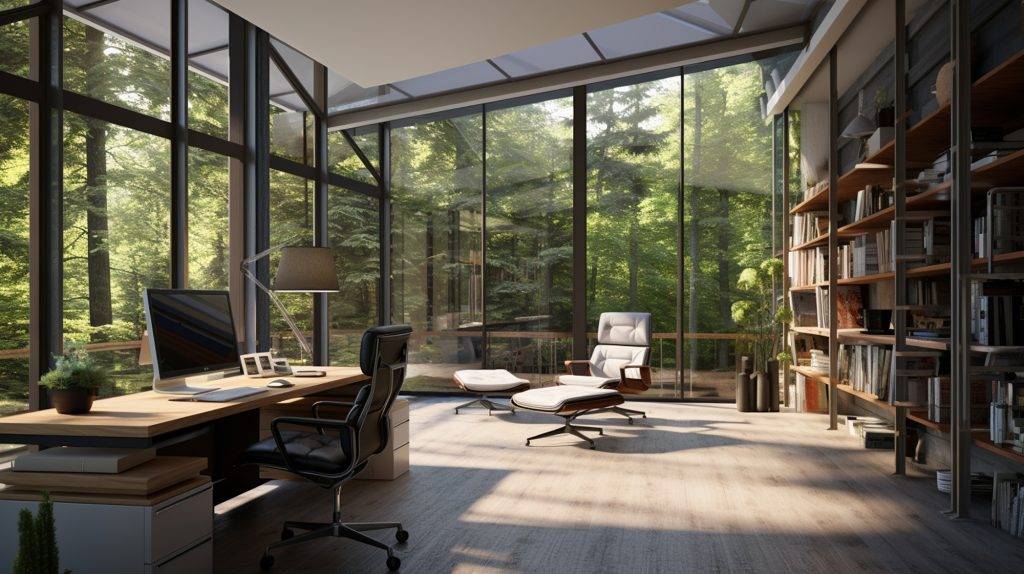Workspaces are not the same as they used to be. Are you noticing the transformation of work environments? Certainly, you can perceive the changing nature of the workplace. Envision a vibrant office building equipped with state-of-the-art technology, and a serene home office, tailored to your personal preferences. Each work environment presents its unique advantages and challenges. Keep reading to discover more.
Contents:
- Modern work environments: Pros and cons
- Flexibility
- Time management
- Maintaining a healthy work-life balanced
- Tips for working from home
- Stress management
- Integration of technology
- Digital communication tools
- Workspaces and data security
- Working in the digital workplace, with or without apps
- Summary
Every couple of years there is a transformation to workspaces but it feels like the pandemic caused an influx of change beyond the normal trends. Many have already experienced it. Working from home can be highly productive, provided it is handled correctly. It offers the opportunity to work in a familiar environment while eliminating commuting time. Moreover, it allows employees to have more flexibility with their time and focus on their tasks without being disturbed by office gossip or other distractions.
The percentage of people working from home is barely decreasing after the pandemic. A quarter of all employees, who have become accustomed to this new freedom, will consider it when looking for jobs in the future. The evaluations by Gallup prove that the potential of remote work is not fully utilized. They predict that 56% of employees perform tasks that can be done from home. The same trend can be seen across Europe: Germany lags far behind the frontrunner, the Netherlands, with over 50% of employees being allowed to occasionally work from home.
Modern work environments: Pros and cons
Not everything that glitters is gold. Working from home presents its own set of challenges. The boundaries between work and leisure can blur, increasing the likelihood of overworking or experiencing burnout. Moreover, it becomes difficult to concentrate when household noises, family members, or pets constantly distract you. Therefore, it’s crucial to establish a quiet and organized workspace and set clear working hours. On the other hand, an office without a modern and appealing concept can also result in productivity issues. An outdated office design may demotivate employees and stifle their creativity.
Outdated technology further contributes to prolonged tasks and frustrations. However, a well-designed office equipped with modern technology should enhance productivity. It can create an inspiring environment that fosters collaboration and motivates employees to give their best. By ensuring our offices are well-lit, furnished with ergonomic furniture, and equipped with the latest technology, we create a positive work environment.
Flexibility
Smart buildings represent the next evolution in work environments and workplace dynamics. They go beyond mere structures, transforming into dynamic spaces equipped with advanced technologies that can adapt to the individual needs of employees. These buildings have the ability to quickly and efficiently reconfigure workspaces, effortlessly adapting to changing demands and circumstances. The key components of a smart building – sensors, actuators, networks, and software – work together to create an environment that responds to the needs of the people working within them. For instance, these buildings can adjust lighting to match natural daylight, regulate temperature based on occupancy and time of day, and even control noise levels in different areas.
All these features contribute to a flexible and pleasant workplace that enhances employee productivity and satisfaction. Conversely, in a home office, flexibility is typically even greater. Employees have full control over their work schedules and environment, allowing them to tailor them to their individual preferences and needs. They can decide when to work, where to work, and even how to work. This can lead to increased comfort, reduced stress, and ultimately, higher productivity.
Time management
Smart buildings, with their advanced technology and efficient use of space, can contribute significantly to time savings. These buildings are equipped with intelligent systems capable of automating a variety of tasks, from lighting and temperature control to security monitoring. By automating routine tasks, employees can focus on their core responsibilities instead of spending time managing their environment. Moreover, smart buildings enable more flexible workspace design through efficient space utilization. This can enhance productivity by providing employees with an environment that best suits their specific needs and preferences. Leveraging advanced technologies, these buildings can be quickly and efficiently redesigned to adapt to changing requirements and circumstances.

Contrasting with this, working from home offers employees even greater flexibility and control over their work environment and schedule. It eliminates the need to commute, which often consumes a significant amount of time. Additionally, employees can tailor their work hours and surroundings to best suit their individual needs and preferences. This can result in increased comfort, reduced stress, and ultimately, higher productivity. Overall, both smart buildings and remote work can contribute to enhancing efficiency and productivity by granting employees more time for their core duties while providing a pleasant and flexible work environment. However, it is important to note that each work setting presents its own challenges, making it crucial to strike a balance that accommodates the needs of everyone involved.
Maintaining a healthy work-life balance
Smart buildings play a crucial role in establishing a clear boundary between work and personal life. They provide employees with a dedicated space designed exclusively for carrying out their professional tasks. This can help individuals focus on their responsibilities while inside the building and detach themselves from work when they leave. The physical separation between the workplace and home can help maintain distinct boundaries between work and leisure, avoiding their fusion. In contrast, working from home can blur the lines between work and personal life. Without a clear spatial distinction, employees may struggle to separate their work and private life, leading to issues like overworking and burnout. Additionally, it can be challenging to concentrate on work when constantly surrounded by domestic distractions.
Despite these challenges, working from home also offers numerous advantages. It provides employees with the flexibility to tailor their work to their personal needs and preferences. For instance, they can decide when, where, and even how they work. Furthermore, working from home allows employees to spend more time with their families and tend to household chores during work breaks. Ultimately, the choice between a smart building and working from home depends on the individual needs and preferences of the employee. It is crucial for both employers and employees to consider these factors in order to create a productive and enjoyable work environment.
Tips for working from home
Looking to optimize your home office space for peak performance? There are numerous strategies to boost productivity while working from home. Here are some tips recommended by various sources:
- Maximize your vertical space: Add shelving units to your walls for extra storage. Stylish and functional, floating shelves are a great option.
- Enhance your lighting: Good lighting can reduce eye fatigue and improve your mood.
- Declutter your desk: A clean and organized workspace can minimize distractions and improve focus.
- Invest in lightweight exercise equipment: Physical activity can help reduce stress and enhance cognitive function.
- Create a dedicated workspace: Having a designated area for work can foster a professional environment and improve work-life balance.
- Minimize clutter: An organized workspace can minimize distractions and increase productivity.
Studies show that remote workers spend an average of 10 minutes less per day being unproductive, work an additional week, and are 47% more productive.
Stress management
Smart buildings utilize advanced technologies to create a pleasant and stress-free environment. By integrating technologies such as the Internet of Things (IoT), these buildings can gather and analyze data to optimize the workspace. For instance, sensors can monitor and adjust temperature, lighting, and noise levels to establish a comfortable atmosphere. Moreover, they facilitate the recognition of employee behaviors and preferences, allowing for tailored adjustments to the environment. Smart buildings can even incorporate technologies for active stress reduction, such as designated areas with calming lighting and music, aimed at aiding relaxation. Some smart buildings even go as far as utilizing advanced technologies like Virtual Reality and mindfulness apps for this purpose.
Overall, smart buildings offer a range of technologies and features that can help reduce workplace stress and improve employee well-being. However, it is important to note that the effectiveness of these technologies depends on various factors, including the specific needs and preferences of the employees. Outside of the office, stress management is primarily in the hands of the individuals, some of whom excel at identifying and regulating stress, while others may struggle. In such cases, providing training and development opportunities can be instrumental in supporting the workforce.
Integration of technology
Smart buildings embody the pinnacle of technological innovation in today’s workspaces. They are frequently equipped with state-of-the-art technology that not only enhances the comfort and efficiency of the work environment but also optimizes workflow. For instance, automated lighting and climate systems can ensure that the workspace is perfectly tailored to the needs of employees, leading to improved concentration and productivity. On the other hand, digital conference rooms enable seamless communication and collaboration regardless of participants’ locations. In contrast, integrating technology seems to pose a greater challenge in the context of working from home. The technological setup in a home office heavily relies on individuals’ preferences and capabilities, making it harder to establish a consistent and efficient technological environment.
However, this also leads to greater flexibility as employees can customize their work environment and tools according to their specific needs and preferences. While both smart buildings and home offices have their own advantages and disadvantages, they represent significant progress in how we work. By leveraging technology, we can create work environments that are both productive and enjoyable, bringing together the best of both worlds. An important factor to consider, which should not be underestimated, is the aspect of interoperability, both in terms of technology and culture. Regardless of where employees are productive, they should be able to collaborate as if they were in the same physical space. That’s the objective.
Digital communication tools
In today’s modern work environment, whether it’s a smart building or a home office, digital communication tools have become indispensable. They have fundamentally transformed the way we communicate and collaborate, helping us overcome the barriers of time and space. Email and instant messaging are now standard tools in almost every company, enabling quick and efficient communication among employees, no matter where they are located. These real-time communication tools can significantly increase productivity by providing instant feedback and reducing the time needed for task coordination and clarification.
Furthermore, video conferencing has changed the way we conduct meetings and collaborate. It allows employees to meet “face-to-face” even when they are thousands of kilometers apart. This can help prevent misunderstandings and foster closer collaboration, as participants can see and interpret non-verbal cues such as facial expressions and body language. These digital tools are particularly crucial in a world where an increasing number of people work remotely. They enable effective and efficient collaboration regardless of whether employees are in a highly advanced smart building or the comfort of their own homes. They exemplify how technology can help tackle the challenges of the modern work environment and create a flexible, responsive, and productive workspace.
Workspaces and data security
In today’s digital work environment, the security of data and information is of utmost importance. Smart buildings, often considered strongholds of technology and security, typically adhere to high standards of safety. These structures are equipped with state-of-the-art security systems that ensure both physical and digital safety. Access control systems, surveillance cameras, and firewalls are just a few examples of measures in place to prevent unauthorized access and protect sensitive data.
However, when working from home, ensuring data security often poses a greater challenge. Without the advanced security systems found in smart buildings, employees are often left to protect their own data and information. This may require implementing various measures, such as establishing secure networks, utilizing Virtual Private Networks (VPNs) for secure internet communication, and regularly updating software to patch any potential security vulnerabilities.
It is crucial to note that security is not solely a technical matter but also a human one. Even the most advanced security system can be rendered ineffective if employees are not well-informed about and compliant with best practices for data security. Therefore, it is essential to provide regular training to employees, keeping them abreast of the latest threats and security measures. Ultimately, data security in the modern work environment is a shared responsibility, encompassing both technological and human components. Whether in a smart building or a home office, it is vital for all parties involved to contribute their part in protecting the data and information critical to the success of the company.
Working in the digital workplace, with or without apps
While the digital work environment offers numerous applications and apps to boost productivity and enhance communication, it’s important to recognize that not all employees are equally tech-savvy or inclined to use them. In fact, there are some who prefer to work without relying on apps. Hence, it’s crucial that we create workspaces that also accommodate these employees. Smart buildings have the ability to provide such inclusive work environments. They are often equipped with various technologies that help streamline workflow and increase productivity, without the need for employees to rely on apps. A prime example of this is digital signage kiosks.

Digital signage kiosks are interactive screens installed in smart buildings, providing employees with a wealth of information and services. They can display current news and updates, offer directions within the building, and even enable bookings for conference rooms and other facilities. These user-friendly kiosks require no special technical knowledge or app downloads, making them an excellent solution for employees who prefer a streamlined experience.
Ultimately, the goal is to create a work environment that respects and caters to the needs and preferences of all employees. Whether through the use of apps or other technologies like digital signage kiosks, we should always strive to foster an inclusive, productive, and enjoyable workplace. Moreover, it’s important to remember that technology is a tool meant to support us in our work, not the other way around. Therefore, it is essential to schedule “digital detox” periods and ensure that our technology promotes a healthy work-life balance rather than undermining it.
Summary
In summary, both smart buildings and home offices offer unique advantages. With careful planning and utilization of available technology, both work environments can contribute to achieving a better work-life balance and enhancing employee satisfaction and productivity. It is crucial to listen to teams and employees, whether in a modern office building or a home office. The future of work is digital, flexible, and tailored to meet the needs of employees. With the right balance and tools, any workplace can become a productive and enjoyable space. Who knows what exciting possibilities the future holds?
